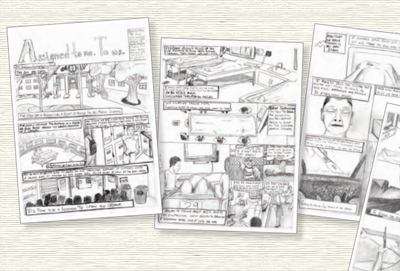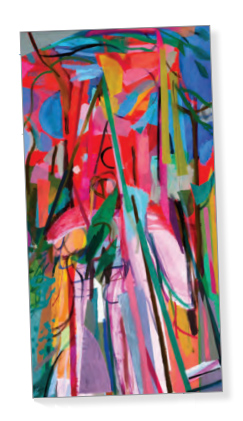Learning at the Intersection of Art and Science
The Medical Humanities program broadens the minds of future doctors.
By Elisa Ludwig
Physicians don't treat patients in a vacuum, and the study of medicine can't be isolated from the human experience. For more than 40 years, the College of Medicine's vital and still-growing humanities program has equipped students with greater insight about the world outside of the examination room.
"The more people study the humanities, the more well-rounded they are," says visiting Artist in Residence Emily Steinberg. "When we are exposed to more ideas, it shifts the way we think."

Drawings made by second-year student Andrew DiMatteo for the Graphic Medicine course are a visual narrative of his personal experience in Gross Anatomy Lab.
The Medical Humanities program officially launched in 1976 within the Department of Community Medicine at the Medical College of Pennsylvania. The school sought to address questions of ethics in the face of what were then new developments, such as organ transplantation, artificial organs and life-extending technology.
"There arose a belief that students should gain understanding of ethical issues in medicine and medical research," says historian Steven J. Peitzman, MD, a professor in the Division of Medical Education. "A related concern was that medicine had become so science-based and technologic that the ‘human element' was being lost, and that study of the humanities within medical education might address this."
An early adopter of what would become a trend in medical education, MCP attracted some students specifically because of its interdisciplinary offerings. Over the years, courses in history of medicine, medical anthropology and art were added to the roster.
The current program includes at least ten electives, which students can opt for individually or as part of the Medical Humanities Scholar Track. Subjects include Poetry and Medicine taught by published poet Kelley White, MD; Being at the Bedside (compassion and mindfulness), led by program director Steven Rosenzweig, MD; literature; and philosophy. In addition, there are Medical Humanities Grand Rounds and special events, such as Peitzman's popular tour of Philadelphia's medical history that begins with a meal and an overview lecture. While most classes are taught by medical school faculty and students, two scholars in residence and visiting artists offer their own perspectives.

The Cherry Tree, 2011, by Bill Scott (Woodmere Art Museum) is one of the works used in the course Training the Physician’s Eye: Enhancing Clinical Skills Through Art Observation, taught by Florence Gelo, DMin, NCPsyA.
Graphic Medicine
As an artist in residence, Steinberg came to Drexel in 2019 to teach a class on Graphic Medicine, a growing genre of comics and graphic novels centered on stories of patients or doctors. (An example is her own comic Mid-Century Hipster, an intimate account of her hip replacement surgery, at emilysteinberg.com.)
Steinberg currently works with five second-year students who are creating illustrated stories about their first exposure to the anatomy lab and cadavers. No previous fine arts experience is necessary, though Steinberg has seen some surprising talent.
"The students have been incredible — I'm impressed with their professionalism, their intelligence, their empathy and, most of all, their willingness to jump into something they might not know anything about," Steinberg says. "For them, it seems to be a real relief and release — a place they can explore a different way of thinking, where they can reach and make mistakes and not worry about perfection."
Steinberg has found there are myriad stories in the world of health care, and visual narratives can uniquely capture the pain, confusion, grief and humor when both patients and providers come up against the body's limitations.
"These stories have difficult details that can be hard to talk about. Images allow you to express that in bold, blunt, visceral terms. The students are not talking about medicine in a dry way here; they can inject the emotional reality into the story."

Drawings made by second-year student Andrew DiMatteo for the Graphic Medicine course are a visual narrative of his personal experience in Gross Anatomy Lab.
Second-year medical student Marc Hem Lee found his way into the program when he initially attended Medical Humanities Grand Rounds. That inspired him to sign up for Dr. Ted Fallon's Reflective and Creative Writing class and ultimately opt for the Scholar Track.
"It is through art that we take time to process what is happening around us, especially as it often occurs at a pace that many students find quite challenging," Hem Lee says. "Writing — really any form of storytelling — is a great way to help put my experience as a medical student into perspective."
Medical Theater
Hem Lee, a seasoned actor and acting instructor who studied theater as an undergraduate at Cornell University and has a graduate degree in acting from East 15 Acting School in London, now teaches his own class, Medical Theater. Students are required to see a play in the Philadelphia area, which Hem Lee views as a chance to better understand the culture of the city, or what he calls the "pulse of a community," and how theater (and doctors using performance modalities) can empower people.
"Every acting technique has its merits and challenges," Hem Lee says. "For example, improvisation is great for pushing your comfort zone and problem-solving in the moment, yet you often lack opportunities to refine that process — something that is more naturally explored in a traditional rehearsal setting with scripted work. We do improvisation for one class, movement for another, voice training for a third, and so on. I aim for versatility, creating different experiences from which students can draw to adapt to a myriad of situations."

Literature and Medicine Book Club, taught by Drexel English department faculty Edward Fristrom, PhD, meets five times to discuss five very different books.
As with Steinberg's class, this opportunity is open to all students, regardless of previous exposure to theater or performance, Hem Lee says. "Do I expect my students to be actors? Well, yes, in the sense that we all have roles to play on any given day, in any given phase of our life."
In a culture that has steadily devalued the humanities in education, the idea that medical students should spend their time reading philosophy, writing poetry or studying history can almost seem radical. Whether as an area of concentration or as an elective chosen on a whim, the humanities have much to teach future doctors, says Peitzman.
Students walk away with "a broader view of medicine as an enterprise, a way to add to their understanding of the experience of illness and the experience of doctoring, and a chance to exercise analytical observation and thinking."
These "soft skills" are misnamed, Hem Lee says, because medical practitioners rely on them on a daily basis. "As we transition from the part of student to that of doctor, I hope to show student-artists that the medical practice requires their humanness, too."
Back to Top